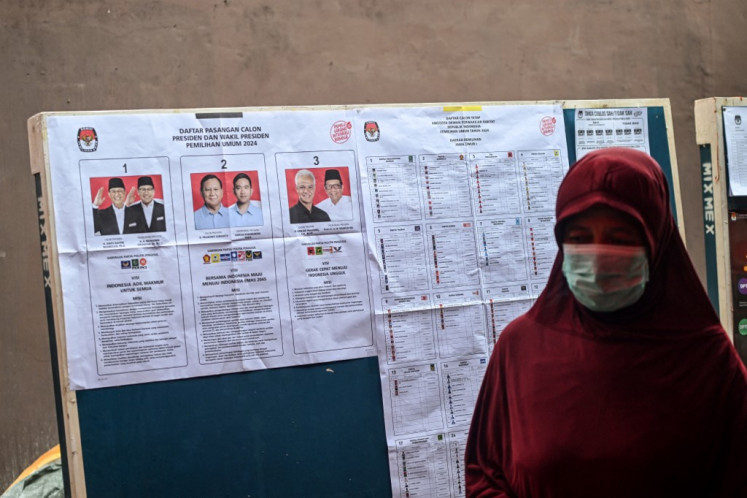Popular Reads
Top Results
Can't find what you're looking for?
View all search resultsPopular Reads
Top Results
Can't find what you're looking for?
View all search resultsQuo vadis the peace dialogue for Papua?
Over a year ago, in February 2012, we were moved by the willingness of President Susilo Bambang Yudhoyono to engage in dialogue with Papuans
Change text size
Gift Premium Articles
to Anyone
O
ver a year ago, in February 2012, we were moved by the willingness of President Susilo Bambang Yudhoyono to engage in dialogue with Papuans. He expressed his commitment publicly during his audience with Papuan church leaders. After 12 months, however, we have not seen much progress in honoring his promise.
While we wait for any sign of follow-up, we have been struck by the shooting incidents in the Mulia area. Eight soldiers and four civilians were shot dead and some others are in a critical condition.
These incidents not only exemplify the unresolved 50-year conflict, but more importantly pose a serious threat to Papuan peace initiatives promoted by Papuan and Indonesian civil society. The incidents might also have reinforced the skeptics’ belief that peace dialogue with Papua is not workable. Even such a prominent figure in the Aceh peace process Jusuf Kalla seems to be convinced that an armed separatist group has to be dealt with by arms.
All these pessimistic interpretations, however, overlook the broader reality of the effectiveness of peace dialogue around the world. Among the extensive research on peace-building, let us highlight two examples which deal with empirical evidence.
First is the 2012 Human Security Report. The report examines four different ways to end conflicts: Peace agreement, cease-fire, victory and other terminations during the period of 1950-2004. Statistical figures show that the effectiveness of peace agreement in ending conflict is slightly lower (32 percent) than cease-fires (38 percent).
But the report also demonstrates that “although peace agreements are less stable than victories, they lead to a much greater reduction in battle deaths.” The figure evinces a more than 80 percent reduction in death tolls after a peace agreement even if it fails and conflict restarts again. This effect does not apply to all other types of terminations. Over all, a peace agreement is empirically more effective in stemming violence by addressing root causes of violence. This process has resulted in the dramatic reduction in death tolls.
Second is Chenoweth and Stefan’s Why Civil Resistance Works: The Strategic Logic of Nonviolent Conflict (2011). Based on 323 case studies worldwide from 1900 to 2006, their research shows that nonviolent resistance was successful in 53 percent of cases in comparison to only 26 percent of armed struggles in achieving the objectives of a resistance movement. The core factors in the success of nonviolent methods lie in their ability to cause the defection of state security forces to take the side of nonviolent movements and to mobilize broad participation from a general public.
This study gives us good grounds to argue that in the long run nonviolent resistance in Papua, particularly the call for peace dialogue, is more likely to succeed than violent resistance. More importantly, the study suggests that nonviolent resistance is much more capable of broadening its participation, including from state security forces.
In other words, both examples give us empirical grounds to conclude that peace dialogues have worked effectively to end conflict in many contexts. Further, in comparison to other types of conflict resolution, peace dialogue works better in comprehensively addressing the root causes of violence. Therefore, we can adequately surmise that the same approach will likely work for Papua.
These studies also resonate with the existing Papuan peace initiatives under the banner “Papua Land of Peace”. This is not just a slogan. Rather, it is the deeply philosophical and religious conviction of Papuan civil society, which reflects on the Papuan memoria passionis (memory of suffering) following the violent 1998 Biak incident. The memoria passionis, however, does not merely record the story of Papuan victimhood. Rather, it is all about the energy of change and the politics of hope to craft a better and just future.
The memory vividly preserves the 50-year history of Papuans and consolidates the energy of emancipation into the Papuan call for dialogue. This is the locus of the Papua Peace Network’s passion for peace. This is the context in which the Tji Hak-Soon justice and peace award for Father Neles Tebay must be understood.
The award has not only renewed Papuans’ calls for a peace dialogue, but also shows the commitment of the international community to endorsing Father Tebay’s tireless efforts for peace. The international community recognizes Papuan peacemaking. The world remains a strong believer in peace and justice.
The writer, a Franciscan friar and former director of the Office for Justice and Peace of the Catholic Church in Jayapura, Papua, is currently a PhD scholar at Regulatory Institutions Network, the Australian National University.










